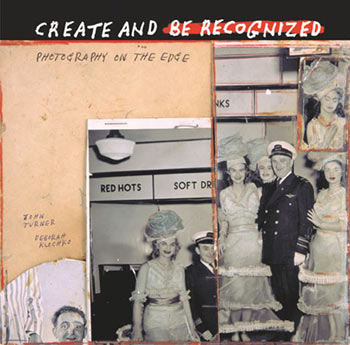Review: Create and Be Recognized by John Turner and Deborah Klochko

In photography, it’s hard to define what an “outsider artist” would be. After all, we’re all photographers! Cameras are ubiquitous. Of course, not everybody is an artist. But still, what would a true “outsider photography artist” look like?
A good example of an outsider photography artist might be Miroslav Tichy. Tichy, who was turned into a photography sensation not that long ago, created his entire photographic oevre by taking photographs of women (without their consent) with homemade contraptions. A lot could be said about his work (and already was), but the similarity with non-photographic outsider artists seems somewhat obvious. Note that he seems to have had at least some actual art training, so being too nitpicky about the criteria of “outsider photography” might not necessarily be too helpful.
Tichy’s work is mentioned (but not given much space) in Create and Be Recognized: Photography on the Edge, a book about what I just called “outsider photography art”. The selection criterion used in the book is quite flexible. Create and Be Recognized: Photography on the Edge
discusses (outsider) artists whose work - to some extent- includes photographic elements. That makes Henry Darger one of the people discussed in it, since his work contains a fairly large amount of photographs, taken from magazines or newspapers, and pasted onto/into his art works.
Create and Be Recognized: Photography on the Edge uses three main categories to show outsider photography/art: Collage (this is where Darger is placed), Photomontage, and Manipulation/Tableau. The different artists introduced in the book present a very interesting mix of art - some of it genuinely great art, some of it a bit less than that. As a survey of how far the boundaries of photography can be stretched, Create and Be Recognized: Photography on the Edge
is a very useful guide.
There’s one thing that I find a bit disturbing, though. One person’s art star might be another person’s creepy old man who is stalking women (and I think I belong to the latter category). The book contains a fairly large number of artists who were either known to have mental problems (such as Adolf Wölfli, who was “diagnosed as a schizophrenic, [and] he spent his entire life at the [Waldau Mental Asylum]”), or where it’s more or less obvious that the artist might have some issues (take the case of Morton Bartlett, who “sculpted anatomically correct plaster figures of children [… the majority of which were girls” and then took photos of those - if that doesn’t convince you looking at the photos will; and then, of course, there’s Tichy). I think connecting outsider photography art to mental illness and/or severe social phobias is a bit dangerous, but Create and Be Recognized: Photography on the Edge certainly leaves ample space for such an interpretation.
Some people might find a lot of the art presented in Create and Be Recognized: Photography on the Edge a bit too weird or disturbing. It is, however, a fascinating survey of photography that is not too frequently seen elsewhere (maybe for good reason).